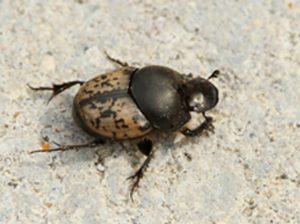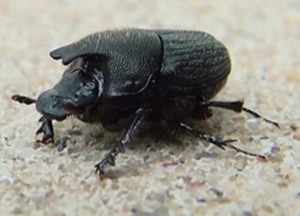194-Beneficial Insect Series 3: Dung Beetles
Fact Sheet No. 194
Prepared by Matthew S. Jones, Graduate Research Assistant and Frank Drummond, Professor of Insect Ecology/Entomology, the University of Maine, Orono, ME 04469. January 2014. This fact sheet was funded in part by the Maine Agriculture and Forestry Experiment Station.
Introduction
Dung Beetles, Coleoptera: Scarabaeidae, are beetles that specialize in consuming the feces of other animals. In Maine, nine species of dung beetles have been collected in wild blueberry fields. These species represent both native and introduced species. Dung beetles provide a variety of ecosystem services within agriculture such as human pathogen and pest insect suppression, increased rates of nutrient cycling in the soil, and enhancement of soil permeability.
Description
In Maine, dung beetles range in size from about a tenth of an inch long (Dialyttellus dialytoides) to almost three-quarters of an inch in length (Geotrupes splendidulous). These beetles have highly sensitive combed antennae used to seek out dung chemical signatures that evaporate into the air, helping them find food resources. Some dung beetle species are quite opportunistic, feeding on a variety of dung types, while others are extremely selective, feeding on only certain specific types of dung. Additionally, different dung beetles fill different ecological niches and occupy different habitat types (ex. forest dwellers vs. field dwellers) depending on the species’ biology.
Two Common Dung beetle species in Maine: Onthophagus nuchincornis (left) and O. hacate (right). Photos: Bugguide.net
Biology
Temperature determines when the beetles will emerge from an overwintering adult stage; different species emerge throughout the spring and summer. After emerging, they search for feces to use as a food resource. Dung beetles bury feces or burrow straight into it, depending on the species. In addition to feeding on dung, mature adults often lay eggs on dung and thus providing the immature larvae with a food source upon egg hatch.
In a field study completed in wild blueberries in Maine, 90-100% of white-tailed deer feces placed in field centers were removed/buried by dung beetles within a four-day period. By burying feces, dung beetles have the ability to reduce human pathogens such as E. coli 0157:H7. In one of our laboratory studies, dung beetles (Onthophagus hecate) consumed the same amount of dung regardless of whether the feces contained pathogenic E. coli or not. With the increased concern about E. coli contamination of foods, the dung beetle is the growers “friend”. As turkeys, deer, and other vertebrate wildlife become more prevalent in blueberry fields, the threat of E. coli contamination of feces (8% of deer feces sampled in Maine blueberry fields were contaminated) possibly contaminating fruit could increase without the intervention of this beneficial insect.
In addition to human pathogen suppression, beetle-mediated dung burial can: suppress wildlife pests (such as face flies and flesh flies) that breed in feces, facilitate nutrient cycling and improve soil permeability. Dung beetles can also be used as indicator species to assess broader biodiversity due to their sensitivity to disturbances.
Management
Several years of research suggested that field management (organic vs. conventional) was not found to significantly affect the abundance of dung beetles in the Maine wild blueberry agroecosystem, probably due to minimal insecticide application in addition to beetles’ subterranean dwelling. However, pesticide usage of less persistent materials is likely to benefit dung beetles, as with most other beneficial arthropods. Different species of dung beetles need different habitat components such as forest canopy cover, open pasture, different soil types, different, specific types of dung, etc.
Additionally, dung beetles require food resources within their foraging territories so, elimination of the wildlife or livestock dung food resource may inhibit the buildup of dung beetle populations, subsequently reducing the aforementioned ecosystem services they can provide. More research is needed to determine how farm management practices in higher-input agroecosystems influence dung beetle population dynamics, as well as the large-scale implications of the presence of dung beetle populations on food safety.
Information in this publication is provided purely for educational purposes. No responsibility is assumed for any problems associated with the use of products or services mentioned. No endorsement of products or companies is intended, nor is criticism of unnamed products or companies implied.
© 2014
Call 800.287.0274 (in Maine), or 207.581.3188, for information on publications and program offerings from University of Maine Cooperative Extension, or visit extension.umaine.edu.
The University of Maine is an EEO/AA employer, and does not discriminate on the grounds of race, color, religion, sex, sexual orientation, transgender status, gender expression, national origin, citizenship status, age, disability, genetic information or veteran’s status in employment, education, and all other programs and activities. The following person has been designated to handle inquiries regarding non-discrimination policies: Director of Equal Opportunity, 101 Boudreau Hall, University of Maine, Orono, ME 04469-5754, 207.581.1226, TTY 711 (Maine Relay System).


